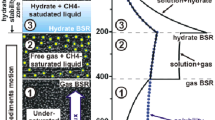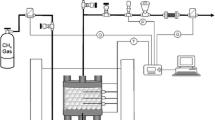Abstract
At the floor and upper sediment layers of the submarine volcano Håkon Mosby gas (methane) hydrate deposits have been discovered. Measurements of the water-dissolved methane concentration at different depths near the volcano have shown that its level is higher than the average level in the Ocean. In order to understand the effects observed in concentration distribution, a model is proposed for describing the propagation of methane formed as a result of decomposition of depth and floor hydrate over the hydrosphere. Within the framework of physical modeling the kinetics of methane dissolution and its distribution in the hydrosphere are traced numerically with account for transfer anisotropy in different directions and undercurrents. The dissolution rate and the mass transfer directions are determined and the concentration fields in the floor layers are calculated. It is shown that methane is rapidly dispersed in the hydrosphere and, thus, significant volumes with high methane concentration cannot be formed. Practical recommendations are given for hunting hydrate deposits in water areas. The model proposed is applicable to describing the propagation of any admixture in different anisotropic media.
Similar content being viewed by others
References
G.D. Ginsburg and V.A. Solovyev, Submarine Gas Hydrates (VNIIOkeanologia, St. Petersburg, 1994) [in Russian].
A.V. Egorov and A.N. Rozhkov, “Formation of Gas Hydrate Reservoirs in Submarine Mud Volcanos,” Fluid Dynamics 45(5), 769–778 (2010).
A.V. Egorov, N.A. Rimskii-Korsakov, A.N. Rozhkov, and E.S. Chernyaev, “First Attempt of Transporting Deep-Water Methane Hydrates in a Non-Hermetic Container,” Okeanologiya 51(2), 376–382 (2011).
I.R. MacDonald, I. Leifer, R. Sassen, et al., “Transfer of Hydrocarbons from Natural Seeps to the Water Column and Atmosphere,” Geofluids 2, 95–107 (2002).
J.W. Pohlman, E.A. Canuel, N.R. Chapman, et al., “The Origin of Thermogenic Gas Hydrates on the Northern Cascadia Margin as Inferred from Isotopic (13C/12C and D/H) and Molecular Composition of Hydrate and Vent Gas,” Organic Geochem. 36, 703–716 (2005).
A.V. Egorov, K. Crane, P.R. Vogt, and A.N. Rozhkov, “Gas Hydrates That Outcrop on the Sea Floor: Stability Models,” Geo-Marine Lett. 19(1–2), 68–75 (1999).
A.M. Bolshakov and A.V. Egorov, “On Using the Phase-Equilibrium Degassing Method in Gasometric Investigations,” Okeanologiya 27(5), 861–862 (1987).
Yu.A. Bogdanov, A.M. Sagalevich, P.R. Vogt, et al., “Mud Volcano Hoakon Mosby in the Norwegian Sea: Results of Integrated Investigations Using Manned Underwater Vehicles,” Okeanologiya 39(3), 412–419 (1999).
A.V. Egorov and G.G. Tsypkin, “Diffusive Dispersion of Natural Gas Hydrates in Ocean Sediments,” Fluid Dynamics 34(1), 144–146 (1999).
B.P. Boudreau and N.L. Guinasso, Jr., “The Influence of a Diffusive Sublayer on Accretion, Dissolution, and Diagenesis at the Sea Floor,” in The Dynamic Environment of the Sea Floor, Ed. by K.A. Fanning and F.T. Manheim (Lexington Books, Lexington, Mass, 1982), pp. 115–145.
Oceanological Investigations and Underwater Technical Works at the Place of Wreck of the Nuclear-Powered Submarine “Komsomolets”, Ed. by M.E. Vinogradov, A.M. Sagalevich, and S.V. Khetagurov (Nauka, Moscow, 1996) [in Russian].
A.G. Rozanov, A.V. Vershinin, A.N. Rozhkov, and V.V. Bogdanovskaya, “Experience of Directly Measuring Oxygen Fluxes at the Water-Floor Interface,” Okeanologiya 31(2), 326–331 (1991).
A.V. Vershinin, A.B. Gornitskii, A.V. Egorov, and A.G. Rozanov, “Method of Studying the Chemical Exchange across the Water-Sediment Interface in the Open Sea Floor System,” Okeanologiya 34(1), 139–145 (1994).
G.G. Tsypkin, “Effect of Decomposition of a Gas Hydrate on the Gas Recovery from a Reservoir Containing Hydrate and Gas in the Free State,” Fluid Dynamics 40(1), 117–125 (2010).
Author information
Authors and Affiliations
Corresponding author
Additional information
Original Russian Text © A.V. Egorov, A.N. Rozhkov, 2014, published in Izvestiya Rossiiskoi Akademii Nauk, Mekhanika Zhidkosti i Gaza, 2014, Vol. 49, No. 5, pp. 93–103.
Rights and permissions
About this article
Cite this article
Egorov, A.V., Rozhkov, A.N. Breakdown of under-water gas hydrate deposits. Fluid Dyn 49, 645–654 (2014). https://doi.org/10.1134/S0015462814050111
Received:
Published:
Issue Date:
DOI: https://doi.org/10.1134/S0015462814050111




